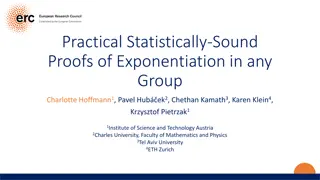Faster Implementation of Modular Exponentiation in JavaScript
Development of a cryptographic authentication toolkit for web application developers. Discusses modular exponentiation, digital signatures, elliptic curve cryptography, and the importance of DSA in providing secure authentication. Aims to offer both classical and elliptic curve cryptographic solutions.
Download Presentation

Please find below an Image/Link to download the presentation.
The content on the website is provided AS IS for your information and personal use only. It may not be sold, licensed, or shared on other websites without obtaining consent from the author.If you encounter any issues during the download, it is possible that the publisher has removed the file from their server.
You are allowed to download the files provided on this website for personal or commercial use, subject to the condition that they are used lawfully. All files are the property of their respective owners.
The content on the website is provided AS IS for your information and personal use only. It may not be sold, licensed, or shared on other websites without obtaining consent from the author.
E N D
Presentation Transcript
For presentation at IIW XXI, October 27-29, 2015 Faster Implementation of Modular Exponentiation in JavaScript Francisco Corella fcorella@pomcor.com Karen Lewison kplewison@pomcor.com 1
Context This work is part of an effort to develop a cryptographic authentication toolkit for developers of web applications Outline Cryptographic authentication Modular Exponentiation JavaScript 2
Cryptographic Authentication A prover can authenticate to a verifier by proving knowledge of a private key The private key may pertain to any kind of public key cryptosystem: Encryption Key exchange Digital signature Digital signature is not objected to by any governments, encryption and key exchange may be subject to export controls 3
Cryptographic Authentication by Digital Signature Verifier generates random nonce A challenge is constructed from material including the verifier s nonce The prover signs the challenge with its private key 4
Digital Signature Cryptosystems RSA 1977 Dual-purpose: encryption, signature DSA Designed by the NSA to provide signature but no encryption ECDSA Elliptic curve version of DSA 5
Elliptic curve vs. classical cryptography Classical crypto (RSA, DSA, DH) relies on the difficulty of factoring (RSA) or computing discrete modular logarithms (DSA, DH) ECC (ECDSA, ECDH, EC version of El Gamal) relies on the difficulty of computing discrete logarithms in the group of points of an elliptic curve ECC requires shorter keys (because it is not vulnerable to index-calculus attacks) and therefore is faster But ECC has a trust problem after the Snowden revelations We plan to provide both classical and elliptic curve crypto in our toolkit 6
DSA Is Important! DSA is the only cryptosystem that nobody objects to: It is not under suspicion of hiding a government back door, even though it was designed by the NSA It is not objected to by governments because it does not provide encryption or key exchange 7
Modular Exponentiation Modular exponentiation is what determines the performance of classical crypto algorithms RSA requires one modular exponentiation for signing, and one with short exponent for verifying RSA with CRT requires two modular exponentiations for signing, with half-size moduli DSA requires one modular exponentiation for signing, two for verifying DH requires one modular exponentiation by each key- exchange participant ECC uses scalar multiplication of curve points instead of modular exponentiation 8
Techniques for Implementing Modular Exponentiation y = gx mod m gx would not fit in any storage Repeated multiply-and-reduce would take forever Square-and-multiply with reduce-as-you-go takes too long if reduction uses division Montgomery reduction avoids division Sliding-window exponentiation improves on square- and-multiply Karatsuba multiplication is asymptotically faster than long multiplication, should help for large moduli 9
Karatsuba Multiplication Recursive multiplication with 3 recursive calls in stead of 4: x = x1b + x0 y = y1b + y0 xy = (b2 + b)x1y1 - b(x1 - x0)(y1 - y0) + (b + 1)x0y0 Karatsuba runs in time (nlog23) instead of (n2) As a rule of thumb, Karatsuba is usually faster when the multiplicands are longer than 320-640 bits (Wikipedia) 10
JavaScript The language of web applications Runs in the browser Originally intended for simple tasks in web pages Now a feature-rich language used on clients and servers Arguably the most important programming language today 11
JavaScript Not Designed for Cryptography Interpreted => slower than a compiled language like C Floating point but no integer arithmetic!!! Options for implementing cryptographic authentication in a web application Web Cryptography API spec of W3C? Stanford JavaScript Crypto Library? 12
Web Cryptography API Appealing: Crypto available to JavaScript apps But implemented in C and/or assembly language and/or hardware But: No DSA! Asynchronous interface!!! Unfinished and in a state of flux 13
Stanford JavaScript Crypto Library (SJCL) Started as a fast implementation of AES in Javascript Paper at 2009 ACSAC: http://bitwiseshiftleft.github.io/sjcl/acsac.pdf GitHub project has added public key cryptography 14
SJCL (continued) But SJCL focuses on ECC No RSA or classical DSA SJCL does provide classical DH, and implements modular exponentiation to that purpose SJCL features Montgomery reduction and sliding-window exponentiation But no Karatsuba multiplication 15
We Chose Another Option: Build our own big integer library and our own crypto algorithms We were hoping to improve modular exponentiation performance by a factor of 2 using Karatsuba Karatsuba did not help for < 4000 bit moduli But we increased performance by a factor of 6 to 8 without Karatsuba! 16
Performance Results for DSA-DH bit lengths in Firefox on Mac with 1.7 GHz 64-bit Processor Security strength 112 128 192 256 Exponent 224 256 384 512 Modulus 2048 3072 7680 15360 Stanford library 74 ms 180 ms 1549 ms 7908 ms Pomcor library 10 ms 23 ms 199 ms 1050 ms Performance improvement 7x faster 8x faster 8x faster 8x faster 17
Performance Results for RSA-with-CRT bit lengths in Firefox on Mac with 1.7 GHz 64-bit Processor Security strength 112 128 192 256 Exponent 2048 3072 7680 15360 Modulus 1024 1536 3840 7680 Stanford library 148 ms 460 ms 6636 ms 50818 ms Pomcor library 25 ms 75 ms 882 ms 7424 ms Performance improvement 6x faster 6x faster 8x faster 7x faster 18
Performance Results for DSA-DH bit lengths in Chrome on Phone with 2.3 GHz 32-bit Processor Security strength 112 128 192 256 Exponent 224 256 384 512 Modulus 2048 3072 7680 15360 Stanford library 315 ms 742 ms 6264 ms 34460 ms Pomcor library 46 ms 103 ms 644 ms using Karatsuba 10x faster 3379 ms using Karatsuba 10x faster Performance improvement 7x faster 7x faster 19
Performance Results for RSA-with-CRT bit lengths in Chrome on Phone with 2.3 GHz 32-bit Processor Security strength 112 128 192 256 Exponent 2048 3072 7680 15360 Modulus 1024 1536 3840 7680 Stanford library 710 ms 2108 ms 29300 ms Not tested Pomcor library 115 ms 263 ms 3263 ms Not tested Performance improvement 6x faster 7x faster 7x faster 20
Practical Benefits With our fast implementation of modular exponentiation on a laptop Crypto authentication using DSA becomes practical on a 64-bit laptop at all security strengths And on a 32-bit phone at security levels 112, 128 and 256 21
Thank you for your attention These slides are available online at http://pomcor.com/documents/ModExpInJS.pptx See also the blog post at http://pomcor.com/2015/10/25/faster-modular- exponentiation-in-javascript/ Or contact us at fcorella@pomcor.com +1.619.770.6765 kplewison@pomcor.com +1.669.300.4510 22























